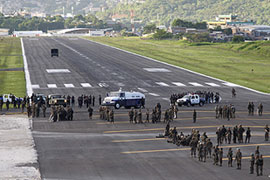Honduras thwarts Zelaya’s return
Deadly clashes break out after ousted president’s aircraft is prevented from landing.

Military aircraft were in the flight path and soldiers and military vehicles were blocking the runway, he said.
Zelaya then headed to El Salvador, to discuss his next move with other Latin American leaders.
He is expected to return to the United States on Tuesday to hold talks with officials from the US State Department, US officials have said.
First fatalities
As Zelaya’s aircraft tried to land on Sunday, the waiting crowd tried to break into the airstrip.
Riot police to fired tear-gas shells and live rounds, resulting in the first known fatalities of the crisis that has engulfed the central American country since the June 28 coup.
| Watch Riz Khan |
 Watch Riz on the death of democracy on Monday at 2030GMT. Programme schedule |
One of the victims was a 10-year-old boy. Several Zelaya supporters were also injured in the violence.
Honduran emergency services confirmed that a child had been killed and a Red Cross spokesman said it was treating about 30 people for injuries.
Soldiers later closed the Tegucigalpa airport. The nightly curfew imposed by the military-backed interim government was moved up by three hours, sending demonstrators home early.
Describing the day’s developments, Al Jazeera cameraman Alfredo Delara said the demonstration had been relatively peaceful until a group of about 100 protesters, mostly youth, started throwing stones and bottles at security forces and tore down a fence separating the two sides.
Troops responded by firing their weapons for about 10 minutes, dispersing most of the crowd, he said.
But some protesters continued to confront the troops and our cameraman witnessed at least one soldier pointing his weapon directly at the protesters and at least one person going down after being shot.
Security operation
Lucia Newman, Al Jazeera’s Latin America editor, said Sunday’s fatalities could be a turning point for the interim government, which had been boasting for days that the coup against Zelaya had been bloodless.
| In video |
|
|
Now that there has been bloodshed, a lot of people were probably thinking that things were getting much messier than they had bargained for and support for the coup may begin to ebb, she said.
In a phone interview to Al Jazeera, Martha Lorena Alvarado, the Honduran minister, defended Sunday’s security operation.
“We are tying to put this country in order because Mr Zelaya wanted to have a replica of Venezuela. If you have ever been to Venezuela, you can foresee our future for the next 20 years,” she said.
“People have the right to demonstrate but they do not have the right to disrupt with rocks, destroying everything and defying the police.”
The interim government had warned Zelaya that, should he try to return, he would be arrested for 18 alleged criminal acts, including treason and failing to implement more than 80 laws approved by congress since taking office in 2006.
Zelaya was removed from power as he was about to press ahead with a non-binding referendum that his domestic critics said was aimed at changing the constitution to enable him to run again for office.
‘Confrontation’
Colin Harding, a Latin American analyst, told Al Jazeera Zelaya was “trying to provoke a confrontation and a showdown and he has succeded in that”.
He said Zelaya was urged not to try to return by Cardinal Rodriguez of Honduras, among others, but “he went ahead anyway”.
 |
| The army blocked the runway to prevent Zelaya’s plane from landing [Reuters] |
“He wasn’t accompanied by Latin American presidents I think because there is a certain amount of uncertainty in the Zelaya camp about the best way to proceed,” Harding said.
“It is inexplicable that his plane was allowed to enter the Honduran airspace and then refused permission to land.
“But behaviour on both sides in this crisis has been very debatable .
“If Zelaya tries to land again presumably the same thing will happen.
“One hopes that some sense prevails and they decide that the time has come now for a negotiated settlement.
“Both sides have hinted every now and then that they might be prepared to enter into discussions and make some concessions, but no format for these dsiscussions has been arrived at.”
Harding also said time had come for “some decisive diplomatic intervention” to get the two sides to start talking to each other.
Call for dialogue
In the run-up to the airport drama, leaders of the interim government gave a televised news conference and called for dialogue with the Organisation of American States (OAS).
The OAS, a hemispheric bloc dedicated to strengthening political co-operation and reforms, suspended Honduras’s membership of the body on Saturday.
“The Republic of Honduras has communicated to the representative of the OAS in Tegucigalpa that it is willing, with the aim of conducting conversations in good faith with a mission of representatives of the secretary general,” Alvarado, the interim deputy foreign minister, said.
Neverthelesss, tensions between Honduras and several of its neighbours sympathetic to Zelaya remain high.
Roberto Micheletti, who was sworn in as Honduras’ president after the coup, said on Sunday that the Nicaraguan military was moving towards the two countries’ shared border.
“We have been informed that in the sector of Nicaragua some troops are moving toward the border,” he said.
A Nicaraguan army spokesman said that the Honduran accusations were “totally false”.

 Honduras protests claim first fatalities
Honduras protests claim first fatalities